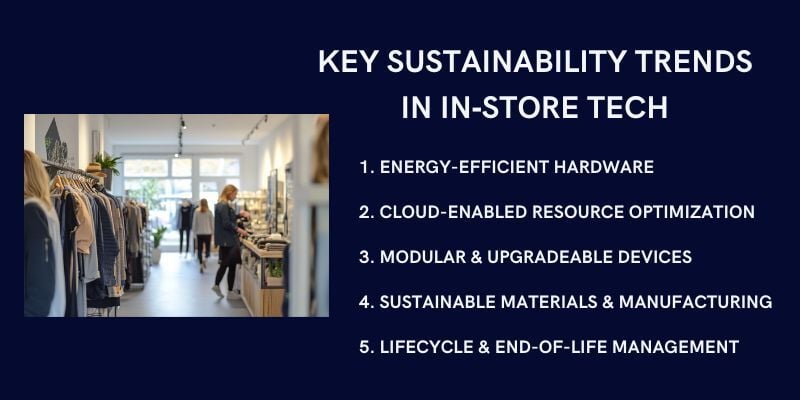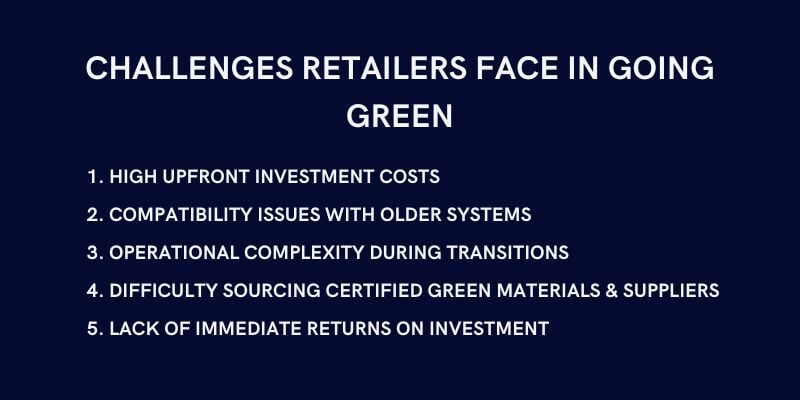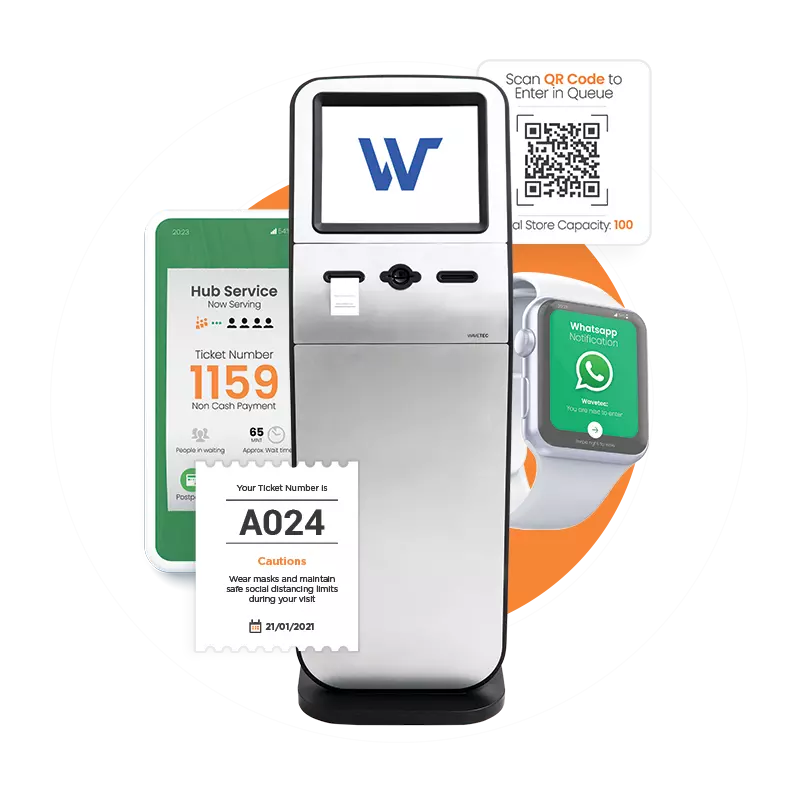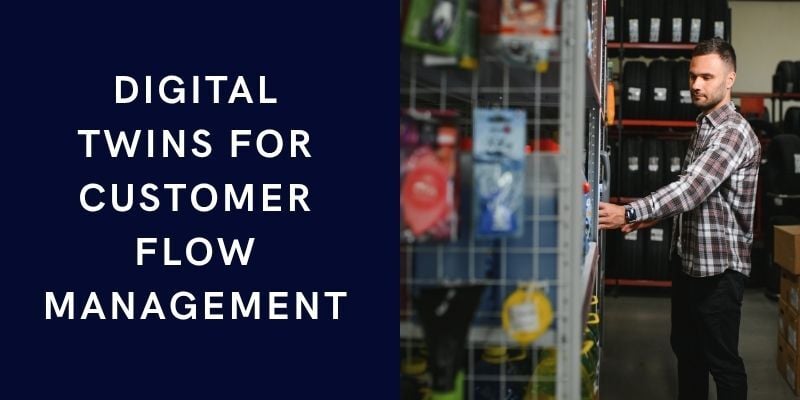Sustainability is becoming a major focus in how retailers plan and operate their stores. Shoppers and regulators now pay close attention to every aspect of the in-store experience, including the technology used within. This includes digital kiosks, self-checkout machines, and electronic shelf labels.
Retailers are transitioning away from wasteful systems and opting for equipment that consumes less energy, lasts longer, and is made from more environmentally responsible materials.
Many are also considering how easily this equipment can be repaired, upgraded, or recycled once it is no longer needed.
These choices are not just about following rules. They help lower energy bills, reduce waste, and show customers that the business is serious about doing better for the environment.
This blog examines sustainability trends in in-store technology deployments, how they are influencing store setups, and what retailers can do to make more informed decisions when introducing new technology into their spaces.
Why Sustainability Now Matters in Retail Tech
Retailers are facing increasing pressure from shoppers, regulators, and investors to adopt greener practices.
A recent Retail TouchPoints study reveals that e-waste has surged by 82%, making it one of the fastest-growing types of waste worldwide and showing the need for better handling of in-store technology.
Meanwhile, another survey found that 78% of consumers now consider sustainability important, and they expect retailers to be accountable not only for their operations but also for the entire supply chain.
This change is more than a marketing move. In-store technology is now expected to help reduce energy consumption, minimize waste, and mitigate the environmental impact of retail technology.
That means choosing equipment that supports sustainable retail operations, such as energy-efficient kiosks and modular hardware.
These choices send a strong message about a retailer’s commitment to the environment, even in retail customer service, where every interaction can reflect brand values.
Regulators are also raising standards, making it essential for retail players to track lifecycle emissions and meet sustainability benchmarks.
Investors are also paying attention and supporting companies that can show real progress in lowering carbon emissions and improving long-term sustainability performance.
As this focus intensifies, in-store setups must support operations in ways that also help achieve sustainability targets.
Key Sustainability Trends in In‑Store Tech

Retailers are taking a close look at their in‑store technology and are now including environmental responsibility at every stage, from powering devices to how they’re built, maintained, and retired.
The following trends show how stores can meet sustainability goals using smart hardware choices:
1. Energy-Efficient Hardware
Retail spaces are using more efficient hardware to lower electricity use and reduce strain on in-store systems.
LED displays are now a common choice because they consume significantly less energy than older display types and have a longer lifespan. These displays also stay cooler, which helps reduce the need for extra cooling and lowers utility costs.
Digital signage, when built with LED technology and paired with scheduling software, can be turned off during non-peak hours without any loss in performance.
Retailers are also choosing hardware with certifications like ENERGY STAR, which indicates that the equipment meets strict energy efficiency guidelines. These efforts support both cost savings and more sustainable use of digital signage throughout the store.
2. Cloud-Enabled Resource Optimization

Cloud-based systems have changed the way in-store technology is maintained. Instead of needing dedicated hardware for every function, stores can now run queue management, self-checkout software, and digital signage through central cloud platforms.
This reduces the number of devices required on site and cuts down on energy use, equipment wear, and storage needs.
Remote diagnostics and updates also make operations smoother. For instance, updates to digital content or queue system settings can be handled off-site, avoiding unnecessary technician visits or equipment swaps.
By limiting physical maintenance and reducing excess hardware, retailers are finding a more sustainable way to manage everyday retail customer service.
Wavetec supports these sustainability goals by offering modular, upgradeable, and cloud-enabled solutions for queue management, self-service kiosks, and digital signage.
With Wavetec’s technology, retailers can reduce energy consumption, minimize on-site hardware requirements, and extend the lifespan of their devices, all while delivering a seamless, modern customer experience.
3. Modular and Upgradeable Devices
More retailers are opting for hardware that is designed to be upgraded, rather than replaced. This includes kiosks, check-in stations, and other self-service units assembled with removable components.
If a screen, printer, or processor becomes outdated, that specific part can be swapped instead of discarding the entire unit.
This approach reduces downtime, minimizes waste, and helps keep store operations running smoothly with fewer disruptions.
One study found that using modular designs for retail kiosks resulted in a 27% reduction in upgrade costs and extended the replacement cycles by 18 months, compared to traditional designs.
Modular units are beneficial when deploying a kiosk in high-traffic areas, as they can be updated on the fly, delivering a longer lifespan and better long-term value.
4. Sustainable Materials and Manufacturing
The materials used in in-store technology are becoming just as important as their functionality. More manufacturers are using recycled metals and plastics to reduce the environmental cost of production.
Devices are also being built with fewer harmful chemicals, and factories are choosing low-emission methods to meet updated manufacturing standards.
Packaging is changing too. Many tech suppliers now use recyclable or minimal packaging to reduce waste at the point of delivery. As these practices become more common, they support the use of green technology in stores without sacrificing quality or performance.
5. Lifecycle and End-of-Life Management
Retailers are no longer waiting for something to break before considering sustainability. Many now track equipment from installation to retirement using asset-management systems.
These systems track device location, usage duration, and maintenance history, allowing teams to determine when to repair or replace units.
At the end of their service life, retail hardware, including kiosks, self-checkout units, and display systems, is either repaired, transferred to secondary locations, or recycled through certified programs.
This prevents unnecessary waste, minimizes security risks, and supports smarter planning. The 2024 Global E‑Waste Monitor reports that in 2022, only 22.3% of the 62 million metric tons of electronic waste generated was formally collected and recycled.
By tracking each device’s lifecycle, retailers can help close that gap, extending hardware use and supporting more responsible, low-impact operations.
How to Balance Customer Experience with Eco Goals
Retailers can now introduce energy-saving retail technology without sacrificing customer satisfaction. With thoughtful design and smart features, it’s possible to maintain a smooth customer experience while meeting eco targets.
Modern displays often feature ambient light sensors that adjust screen illumination based on surrounding light levels.
ENERGY STAR-certified signage, for example, is approximately 4% more efficient than standard displays and offers up to $25 in lifetime savings for each 31- to 60-inch unit.
Some retailers take it a step further by adding motion-triggered activation, which wakes screens only when shoppers approach.
Macy’s flagship store, for example, implemented motion‑based dimming and saved $1.2 million in annual electricity costs while reducing lighting by 42% during peak hours.
These features are not limited to signage. Kiosks and self-checkout units can include motion sensors that enter low-power mode when not in use, making low-impact kiosks smart about energy use while still ready for customers.
Digital signage can also follow scheduled content or display patterns tied to store hours, supporting sustainable digital signage practices without affecting customer experience.
By integrating technologies such as brightness adaptation, motion sensing, and scheduling, retailers can deliver consistent, high-quality service and a positive customer experience.
At the same time, they deliver on eco goals by cutting energy costs and reducing unnecessary operations.
Challenges Retailers Face in Going Green

While many retailers are committed to reducing their environmental impact, the path to sustainability can be a complex one.
One major hurdle is the budget. Upgrading to energy-efficient hardware, integrating smart systems, or redesigning store layouts can require significant upfront investment.
For small to mid-sized retailers, this can delay green initiatives, especially when immediate returns are unclear.
Tech compatibility is another concern. Older systems may not easily integrate with newer, energy-saving platforms or cloud-based dashboards.
For example, a store using outdated POS systems or non-digital displays might struggle to implement smart lighting, analytics, or queue solutions without a full-scale upgrade. This adds to operational complexity and costs.
Sourcing also poses challenges. Retailers often struggle to identify suppliers that meet green manufacturing standards or offer certified low-impact options.
Without a trusted network, procurement teams may revert to conventional choices, slowing progress toward more sustainable operations.
To work around these challenges, retailers can start with phased upgrades. Replacing high-consumption lighting with LED alternatives or investing in modular, self-service kiosks, for instance, can improve retail store energy efficiency without requiring a full overhaul.
Setting realistic, long-term sustainability goals, rather than expecting immediate transformation, also allows companies to make steady improvements without disrupting business continuity.
By approaching sustainability as an ongoing process, retailers can gradually modernize their operations, improve efficiency, and move closer to achieving their environmental targets.
Conclusion
Green technology in stores is no longer a luxury. It is a long-term requirement for any retailer seeking to stay competitive and credible.
As customer expectations and regulations change, businesses need to view sustainability as part of daily operations, and not an occasional upgrade.
A good starting point is to review how current systems perform in terms of energy use, material sourcing, and equipment lifespan. Even small adjustments, such as updating displays or extending the use of kiosks, can lead to lasting savings.
Retailers that make thoughtful changes today are more likely to win customer trust, reduce operating costs, and meet future standards with confidence. The most resilient businesses are those that plan for efficiency and sustainability together.
BOOK A FREE DEMO






